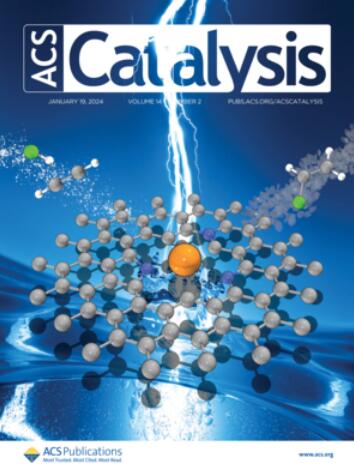基于恒电位第一性原理研究和微动力学建模的竞争性CO2在锡电极上的电化学还原和析氢
IF 11.3
1区 化学
Q1 CHEMISTRY, PHYSICAL
引用次数: 0
摘要
二氧化碳的电化学还原(CO2ER)甲酸提供了一个潜在的解决方案,以碳中性的能源循环。然而,这一过程主要受限于sn基催化剂上HCOOH/HCOO -对H2的选择性较低。尽管进行了广泛的研究,但确切的反应机制仍然存在争议。利用恒电位第一性原理研究和微动力学模型,我们确定了一个涉及Sn(200)上弯曲CO2_v*中间体的反应途径,这明显不同于以往用恒电荷方法研究的反应途径。在此路径下,模拟的CO2ER/析氢反应极化曲线以及Sn(200)上的法拉第效率与实验结果吻合较好。从HCOOH/HCOO -到H2的选择性转换取决于CO2_v*随外加电位变化的稳定性。过稳定和过不稳定的CO2_v*中间体都不利于HCOOH的形成。此外,我们发现增强对HCOO*的吸附可以提高Sn(200)上生成HCOOH/HCOO -的电流密度和选择性。这项工作强调了通过恒电位方法精确描述电化学界面在阐明CO2ER机制中的重要性,并且所获得的见解可能用于开发用于CO2ER和其他重要技术兴趣反应的改进电催化剂。本文章由计算机程序翻译,如有差异,请以英文原文为准。

Competitive CO2 Electrochemical Reduction and Hydrogen Evolution at Sn Electrode through Constant-Potential First-Principles Study and Microkinetic Modeling
The CO2 electrochemical reduction (CO2ER) to formic acid offers a potential solution to a carbon-neutral energy cycle. However, this process is mainly limited by sluggish kinetics and low selectivity for HCOOH/HCOO– over H2 on Sn-based catalysts. Despite extensive research, the exact reaction mechanism remains contentious. Using constant-potential first-principles study and microkinetic modeling, we identify a reaction pathway involving bent CO2_v* intermediate on Sn(200), which is clearly distinct from previous studies by the constant-charge approach. Following this pathway, the simulated CO2ER/hydrogen evolution reaction polarization curves, as well as Faradaic efficiency on Sn(200), exhibit good agreement with experimental findings. The potential-dependent selectivity switch from HCOOH/HCOO– to H2 is attributed to the changing stability of CO2_v* with applied potential. Both excessively stable and overly unstable CO2_v* intermediates are detrimental to HCOOH formation. Moreover, we find that enhancing the adsorption of HCOO* can boost the current density and selectivity for HCOOH/HCOO– production on Sn(200). This work highlights the importance of precisely describing the electrochemical interface by the constant-potential approach in elucidating the CO2ER mechanism, and the insights gained can potentially be used to develop improved electrocatalysts for the CO2ER and other important reactions of technological interest.
求助全文
通过发布文献求助,成功后即可免费获取论文全文。
去求助
来源期刊

ACS Catalysis
CHEMISTRY, PHYSICAL-
CiteScore
20.80
自引率
6.20%
发文量
1253
审稿时长
1.5 months
期刊介绍:
ACS Catalysis is an esteemed journal that publishes original research in the fields of heterogeneous catalysis, molecular catalysis, and biocatalysis. It offers broad coverage across diverse areas such as life sciences, organometallics and synthesis, photochemistry and electrochemistry, drug discovery and synthesis, materials science, environmental protection, polymer discovery and synthesis, and energy and fuels.
The scope of the journal is to showcase innovative work in various aspects of catalysis. This includes new reactions and novel synthetic approaches utilizing known catalysts, the discovery or modification of new catalysts, elucidation of catalytic mechanisms through cutting-edge investigations, practical enhancements of existing processes, as well as conceptual advances in the field. Contributions to ACS Catalysis can encompass both experimental and theoretical research focused on catalytic molecules, macromolecules, and materials that exhibit catalytic turnover.
 求助内容:
求助内容: 应助结果提醒方式:
应助结果提醒方式:


